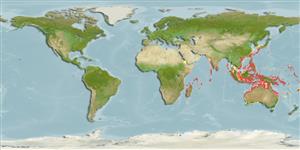Teleostei (teleosts) >
Eupercaria/misc (Various families in series Eupercaria) >
Labridae (Wrasses) > Corinae
Etymology: Pseudojuloides: Greek, pseudes = false + Greek, iouis = a fish without identification, perhaps some of genus Coris cited by Plinius + Greek, oides = similar to (Ref. 45335); severnsi: Named after Mike Severns who organized the collection and deposition of the type material from Alor, Indonesia.
Eponymy: R Michael ‘Mike’ Severns is the dive guide who collected the first specimens of both fish. He operates Mike Severns Diving in Maui, Hawaii. He is also very knowledgeable about the location of fossil deposits and birds. A bird is also named after him. (Ref. 128868), visit book page.
More on authors: Bellwood & Randall.
Environment: milieu / climate zone / depth range / distribution range
Ecology
Marine; demersal; depth range 12 - 40 m (Ref. 90102). Tropical
Indo-West Pacific: Maldives to the western Pacific..
Size / Weight / Age
Maturity: Lm ? range ? - ? cm
Max length : 9.2 cm SL male/unsexed; (Ref. 35870)
Short description
Identification keys | Morphology | Morphometrics
Dorsal spines (total): 9; Dorsal soft rays (total): 11; Anal spines: 3; Anal soft rays: 12. With a large blue-margined black patch covering the posteriodorsal region of the head and the dorsal anterior third of the body, an orange submarginal line along the length of the dorsal fin, and upper and lower rays of the caudal fin forming dark lobes that protrude beyond the medial caudal margin (Ref. 35870).
Mainly in open ground areas covered with rubble; may also be found in areas with rock and coral patches (Ref. 35870). Found in small harems and feeds on material on the substratum (Ref. 35870). Minimum depth reported from Ref. 35870.
Life cycle and mating behavior
Maturity | Reproduction | Spawning | Eggs | Fecundity | Larvae
Oviparous, distinct pairing during breeding (Ref. 205).
Parenti, P. and J.E. Randall, 2000. An annotated checklist of the species of the labroid fish families Labridae and Scaridae. Ichthyol. Bull. J.L.B. Smith Inst. Ichthyol. (68):1-97. (Ref. 35918)
IUCN Red List Status (Ref. 130435: Version 2024-2)
Threat to humans
Harmless
Human uses
Tools
Special reports
Download XML
Internet sources
Estimates based on models
Preferred temperature (Ref.
123201): 24.8 - 28.8, mean 27.5 °C (based on 216 cells).
Phylogenetic diversity index (Ref.
82804): PD
50 = 0.5000 [Uniqueness, from 0.5 = low to 2.0 = high].
Bayesian length-weight: a=0.00977 (0.00466 - 0.02049), b=3.07 (2.90 - 3.24), in cm total length, based on LWR estimates for this (Sub)family-body shape (Ref.
93245).
Trophic level (Ref.
69278): 3.4 ±0.4 se; based on size and trophs of closest relatives
Resilience (Ref.
120179): High, minimum population doubling time less than 15 months (Preliminary K or Fecundity.).
Fishing Vulnerability (Ref.
59153): Low vulnerability (10 of 100).
